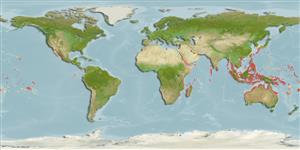>
Ovalentaria/misc (Various families in series Ovalentaria) >
Pomacentridae (Damselfishes) > Pomacentrinae
Etymology: Pomacentrus: Greek, poma, -atos = cover, operculum + Greek, kentron = sting (Ref. 45335).
More on author: Cuvier.
Environment: milieu / climate zone / Tiefenbereich / distribution range
Ökologie
seewasser; brackwasser riff-verbunden; standorttreu; tiefenbereich 0 - 3 m (Ref. 7247). Tropical
Indo-West Pacific: Sri Lanka, Andaman Sea (Phuket), and Indo-Australian Archipelago eastward to New Britain, Solomon Islands, Santa Cruz Islands, and Vanuatu.
Size / Gewicht / Alter
Geschlechtsreife: Lm ? range ? - ? cm
Max length : 7.5 cm SL Männchen/unbestimmt; (Ref. 542)
Rückenflossenstacheln (insgesamt) : 13; Rückenflossenweichstrahlen (insgesamt) : 14 - 15; Afterflossenstacheln: 2; Afterflossenweichstrahlen: 14 - 15.
Body shape (shape guide): short and / or deep; Cross section: compressed.
A shallow water species, solitary, in holes of small rocks on sandy bottom with coral rubbles. Adults inhabit shallow bays, silty coastal reefs and harbors with sparse coral and algal growth. Feed mainly on benthic algae (Ref. 7247). Oviparous, distinct pairing during breeding (Ref. 205). Eggs are demersal and adhere to the substrate (Ref. 205). Males guard and aerate the eggs (Ref. 205). Diurnal species (Ref. 113699).
Life cycle and mating behavior
Geschlechtsreife | Fortpflanzung | Ablaichen | Eier | Fecundity | Larven
Oviparous, distinct pairing during breeding (Ref. 205). Eggs are demersal and adhere to the substrate (Ref. 205). Males guard and aerate the eggs (Ref. 205).
Allen, G.R., 1991. Damselfishes of the world. Mergus Publishers, Melle, Germany. 271 p. (Ref. 7247)
IUCN Rote Liste Status (Ref. 130435: Version 2025-1)
Bedrohung für Menschen
Harmless
Nutzung durch Menschen
Fischereien: weniger kommerziell
Tools
Zusatzinformationen
Download XML
Internet Quellen
Estimates based on models
Preferred temperature (Ref.
123201): 24.6 - 29.3, mean 28.4 °C (based on 2864 cells).
Phylogenetic diversity index (Ref.
82804): PD
50 = 0.5000 [Uniqueness, from 0.5 = low to 2.0 = high].
Bayesian length-weight: a=0.02455 (0.01155 - 0.05216), b=2.98 (2.81 - 3.15), in cm total length, based on LWR estimates for this Genus-body shape (Ref.
93245).
Trophic level (Ref.
69278): 2.0 ±0.00 se; based on food items.
Widerstandsfähigkeit (Ref.
120179): hoch, Verdopplung der Population dauert weniger als 15 Monate. (Preliminary K or Fecundity.).
Fishing Vulnerability (Ref.
59153): Low vulnerability (10 of 100).
🛈
Nutrients (Ref.
124155): Calcium = 173 [79, 298] mg/100g; Iron = 0.884 [0.497, 1.668] mg/100g; Protein = 18.2 [16.9, 19.4] %; Omega3 = 0.0969 [, ] g/100g; Selenium = 14.4 [6.6, 31.8] μg/100g; VitaminA = 93.1 [21.6, 358.4] μg/100g; Zinc = 2.91 [1.83, 4.86] mg/100g (wet weight);
